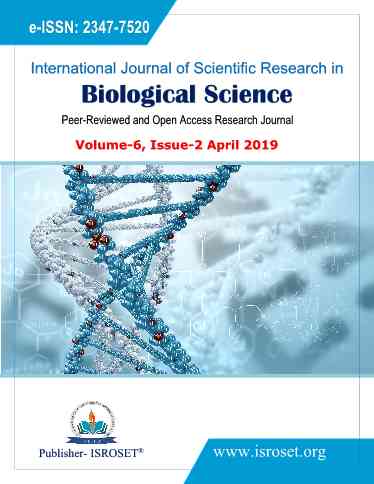Regression Analysis and Docking Study of Pyrimidine Based Compounds as anti-Tuberculosis Therapeutic Agents
Keywords:
Structure activity, biological activity, docking, tuberculosisAbstract
In the drug-design process, structure activity relationship is an important tool for estimation of biological activity of the unknown compounds. In this process, the objective is development of a relationship between structural features of molecules and the property of interest i. e. biological activity. On the basis of this relationship, the biological activity can be predicted for new candidate structures. Initially, the forty two substituted pyrimidine molecules with known biological activities were considered as known set for regression analysis model building purpose. The properties module from Datawarrior used to calculate descriptors. Structure activity model indicates that these descriptors have significant relationships with observed bioactivity. We have observed a high relationship between experimental and predicted activity values, indicating the validation and the excellent quality of the derived model. In the present study, the new substituted pyrimidine molecules are designed, optimized and their descriptors were calculated using Datawarrior modules. Then by using the Regression analysis model, their biological activities are studied as well as inhibition studies for the 1QPQ by molecular docking method are also carried out. Thus on the basis of regression analysis study and docking study of substituted pyrimidine derivatives, we can conclude that these compounds on further studies may prove to be therapeutic agent against tuberculosis.
References
L. H. Hall, "A Structure-Information Approach to the Prediction of Biological Activities and Properties," CHEMISTRY & BIODIVERSITY , vol.1, p.183, 2004.
P. N.Judson, "QSAR and Expert System in Prediction of," Pestic.Sci., pp. 155-160, 1992.
A. Tropsha, "Best Practices for QSAR Model Development, Validation and Exploitation," Mol. Inf., pp. 476-488, 2010.
L. H. L.B. Kier, "Quantitative Information Analysis: The New Center of Gravity in Medicinal Chemistry," Medicinal Chemistry Research, vol. 7, pp. 335-339, 1997.
L. H. H. L. B. Kier, Molecular Structure Description: The Electrotopological State, Academic Press, 1999.
L. B. K. L. H. Hall, Topological Indices and Related Descriptors in QSAR and QSPR, UK, 1999.
J. A. B. George W. Adamson, "Evaluation of an empirical structure–activity relationship for property prediction in a structurally diverse group of local anaesthetics," Journal of the Chemical Society, Perkin Transactions 1, no. 2, pp. 168-172, 1976.
Shams Uzzaman and Ayaz Mahmood Dar , "PATHWAYS FOR THE SYNTHESIS OF PYRIMIDINE AND PYRAN BASED HETEROCYCLIC DERIVATIVES:A CONCISE REVIEW," Eur. Chem. Bull., vol. 4, no. 5, pp. 249-259, 2015.
Vinita Sharma, et. al., "Significance and Biological Importance of Pyrimidine in the Microbial World," International Journal of Medicinal Chemistry, p. 31, 2014.
V. H. Babu, P. S. Kumar, K. K. Srinivasan, and G. V. Bhat, “Synthesis, antitumor and antibacterial activities of certain substituted pyrimidines bearing benzofuran,” Indian Journal of Pharmaceutical Sciences, vol. 66, no. 5, pp. 647–652, 2004.
Sander T1, Freyss J, von Korff M, Rufener C. “DataWarrior: an open-source program for chemistry aware data visualization and analysis” J Chem Inf Model., 55(2), 460-73, 2015.
J. Huuskonen, "Estimation of Aqueous Solubility for a Diverse Set of Organic Compounds Based on Molecular Topology," Journal of Chemical Information and Modeling , pp. 773-777, 2000.
J. M. B. W. Y. W. S. G. F. P. K. Annamaria Lilienkampf, "Structure-Activity Relationships for a Series of Quinoline-Based Compounds Active against," Journal of Medicinal Chemistry, vol. 52, p. 2109–2118, 2009.
A. V. A. ,. N. K. P. ,. I. H. C. Sumesh Eswaran, "Design and synthesis of some new quinoline-3-carbohydrazone derivatives as potential antimycobacterial agents," Bioorganic & Medicinal Chemistry Letters, p. 1040–1044, 2010.
P. M. R. a. B. G. K. Ganatra S. H., "Inhibition Studies of Pyridine Based Compounds on Quinolinic Acid Phosphoribosyltransferase Enzyme as A Potent Anti-Tuberculosis Agent" Asian J. Research Chem, vol. 5, no. 9, pp. 1159-1165, 2012.
Kai-Cheng Hsu, Yen-Fu Chen, Shen-Rong Lin, Jinn-Moon Yang. “iGEMDOCK: a graphical environment of enhancing GEMDOCK using pharmacological interactions and post-screening analysis” BMC Bioinformatics 2011, 12(Suppl 1):S33
P. N. Judson, "QSAR and Expert Systems in the Prediction of," Pestic. Sci., pp. 155-160, 1992.
L. H. H. L. B. Kier, Research Studies Press, 1986.
Sunita Patel Hardia, “Topological Modeling of log D7.4 of Hydroxylated Aromatic Aldehydes” IJSRCS, Vol.2 , Issue.1 , pp.1-4, Dec-2015.
Asmita Sharma and Anubha Vijay Pandya, "Modeling of sulfonamide using NMR chemical shift by QSDAR Method", International Journal of Scientific Research in Chemical Sciences, Vol.1, Issue.1, pp.1-8, 2014.
A. K. Parmar, M. R. Patle, "Regression Analysis and Docking Study of Hydroxyl Quinoline Based Compounds as Anti-Tuberculosis Therapeutic Agents", International Journal of Scientific Research in Biological Sciences, Vol.6, Issue.1, pp.177-186, 2019.
SPSS version 24 for Windows. SPSS software packages, SPSS Inc., 444 North Michigan Avenue, Suite 3000, Chicago, Illinois, 60611, USA.
Downloads
Published
How to Cite
Issue
Section
License

This work is licensed under a Creative Commons Attribution 4.0 International License.
Authors contributing to this journal agree to publish their articles under the Creative Commons Attribution 4.0 International License, allowing third parties to share their work (copy, distribute, transmit) and to adapt it, under the condition that the authors are given credit and that in the event of reuse or distribution, the terms of this license are made clear.







